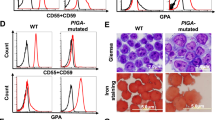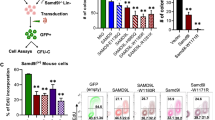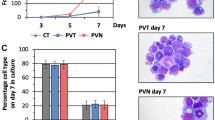Abstract
Paroxysmal nocturnal hemoglobinuria (PNH) is an acquired stem cell disorder characterized clinically by intravascular hemolysis, venous thrombosis, and bone marrow failure. Despite elucidation of the biochemical and molecular defects in PNH, the pathophysiology of clonal expansion of glycosylphosphatidylinositol-anchored protein (GPI-AP)-deficient cells remains unexplained. In pursuit of evidence of differences between GPI-AP-normal and -deficient CD34 cells, we determined gene expression profiles of isolated marrow CD34 cells of each phenotype from PNH patients and healthy donors, using DNA microarrays. Pooled and individual patient samples revealed consistent gene expression patterns relative to normal controls. GPI-AP-normal cells from PNH patients showed upregulation of genes involved in apoptosis and the immune response. Conversely, genes associated with antiapoptotic function and hematopoietic cell proliferation and differentiation were downregulated in these cells. In contrast, the PNH clone of GPI-AP-deficient cells appeared more similar to CD34 cells of healthy individuals. Gene chip data were confirmed by other methods. Similar gene expression patterns were present in PNH that was predominantly hemolytic as in PNH associated with aplastic anemia. Our results implicate an environmental influence on hematopoietic cell proliferation, in which the PNH clone evades immune attack and destruction, while normal cells suffer a stress response followed by programmed cell death.
This is a preview of subscription content, access via your institution
Access options
Subscribe to this journal
Receive 12 print issues and online access
$259.00 per year
only $21.58 per issue
Buy this article
- Purchase on Springer Link
- Instant access to full article PDF
Prices may be subject to local taxes which are calculated during checkout



Similar content being viewed by others
References
Hall C, Richards SJ, Hillmen P . The glycosylphosphatidylinositol anchor and paroxysmal nocturnal haemoglobinuria/aplasia model. Acta Haematol 2002; 108: 219–230.
Rosse W . A brief history of PNH. In: Young NS, Moss J (eds). PNH and the GPI-linked Proteins. San Diego: Academic Press, 2000, pp 1–20.
Okuda K, Kanamaru A, Ueda E, Kitani T, Okada N, Okada H et al. Expression of decay-accelerating factor on hematopoietic progenitors and their progeny cells grown in cultures with fractionated bone marrow cells from normal individuals and patients with paroxysmal nocturnal hemoglobinuria. Exp Hematol 1990; 18: 1132–1136.
Dunn DE, Yu J, Nagarajan S, Devetten M, Weichold FF, Medof ME et al. A knock-out model of paroxysmal nocturnal hemoglobinuria: Pig-a(−) hematopoiesis is reconstituted following intercellular transfer of GPI- anchored proteins. PNAS 1996; 93: 7938–7943.
Rosti V, Tremmi G, Scares V, Pandolfi PP, Luzzatto L, Bessler M . Murine embryonic stem cells without pig-a gene activity are competent for hematopoiesis with the PNH phenotype but not for clonal expansion. J Din Invest 1997; 100: 1028–1036.
Kawagoe K, Kitamura D, Okabe M, Taniuchi I, Ikawa M, Watanabe T et al. Glycosylphosphatidylinositol-anchor-deficient mice: implications for clonal dominance of mutant cells in paroxysmal nocturnal hemoglobinuria. Blood 1996; 87: 3600–3606.
Brodsky RA, Vala MS, Barber JP, Medof ME, Jones RJ . Resistance to apoptosis caused by PIG-A gene mutations in paroxysmal nocturnal hemoglobinuria. PNAS 1997; 94: 8756–8760.
Ware RE, Nishimura J, Moody MA, Smith C, Rosse WF, Howard TA . The PIG-A mutation and absence of glycosylphosphatidylinositol-linked proteins do not confer resistance to apoptosis in paroxysmal nocturnal hemoglobinuria. Blood 1998; 92: 2541–2550.
Chen R, Nagarajan S, Prince GM, Maheshwari U, Terstappen LW, Kaplan DR et al. Impaired growth and elevated Fas receptor expression in PIGA(+) stem cells in primary paroxysmal nocturnal hemoglobinuria. J Clin Invest 2000; 106: 689–696.
Chen G, Kirby M, Zeng W, Young NS, Maciejewski JP . Superior growth of glycophosphatidylinositol-anchored protein-deficient progenitor cells in vitro is due to the higher apoptotic rate of progenitors with normal phenotype in vivo. Exp Hematol 2002; 30: 774–782.
Walker J, Flower D, Rigley K . Microarrays in hematology. Curr Opin Hematol 2002; 9: 23–29.
Polacek DC, Passerini AG, Shi C, Francesco NM, Manduchi E, Grant GR et al. Fidelity and enhanced sensitivity of differential transcription profiles following linear amplification of nanogram amounts of endothelial mRNA. Physiol Genomics 2003; 13: 147–156.
Peng X, Wood CL, Blalock EM, Chen KC, Landfield PW, Stromberg AJ . Statistical implications of pooling NA samples for microarray experiments. BMC Bioinformatics 2003; 4: 26.
Zhao H, Hastie T, Whitfield ML, Borresen-Dale AL, Jeffrey SS . Optimization and evaluation of T7 based RNA linear amplification protocols for cDNA microarray analysis. BMC Genomics 2002; 3: 31.
Kendziorski CM, Zhang Y, Lan H, Attie AD . The efficiency of pooling mRNA in microarray experiments. Biostatistics 2003; 4: 465–477.
Zeng W, Chen G, Kajigaya S, Nunez O, Charrow A, Billings EM et al. Gene expression profiling in CD34 cells identifies significant differences between aplastic anemia patients and health volunteers. Blood 2003; 103: 325–332.
Chen G, Zeng Z, Miyazato A, Billings E, Maciejewski JP, Kajigaya S et al. Distinctive gene expression profiles of CD34 cells from patients with myelodysplastic syndrome characterized by specific chromosomal abnormalities. Blood 2004; 104: 4210–4218.
Livak KJ, Schmittgen TD . Analysis of relative gene expression data using real-time quantitative PCR and the 2(−ΔΔCT) Method. Methods 2001; 25: 402–408.
Zang DY, Goodwin RG, Loken MR, Bryant E, Deeg HJ . Expression of tumor necrosis factor-related apoptosis-inducing ligand, Apo2L, and its receptors in myelodysplastic syndrome: effects on in vitro hemopoiesis. Blood 2001; 98: 3058–3065.
Peter ME, Krammer PH . Mechanisms of CD95 (APO-1/Fas)-mediated apoptosis. Curr Opin Immunol 1998; 10: 545–551.
Lane BR, Liu J, Bock PJ, Schols D, Coffey MJ, Stricter RM et al. Interleukin-8 and growth-regulated oncogene alpha mediate angiogenesis in Kaposi's sarcoma. J Virol 2002; 76: 11570–11583.
Umemura M, Nishimura H, Yajima T, Wajjwalk W, Matsuguchi T, Takahashi M et al. Overexpression of interleukin-15 prevents the development of murine retrovirus-induced acquired immunodeficiency syndrome. FASEB J 2002; 16: 1755–1763.
Soejima K, Rollins BJ . A functional IFN-gamma-inducible protein-10/CXCLlO-specific receptor expressed by epithelial and endothelial cells that is neither CXCR3 nor glycosaminoglycan. J Immunol 2001; 167: 6576–6582.
Albanese P, Chagraoui J, Charon M, Cocault L, Dusanter-Fourt I, Romeo PH et al. Forced expression of p21 in GPIIb-p21 transgenic mice induces abnormalities in the proliferation of erythroid and megakaryocyte progenitors and primitive hematopoietic cells. Exp Hematol 2002; 30: 1263–1272.
Seki N, Hattori A, Hayashi A, Kozuma S, Ohira M, Hori T et al. Structure, expression profile and chromosomal location of an isolog ofDNA-PKcs interacting protein (KIP) gene. Biochim Biophys Acta 1999; l444: 143–147.
Wang N, Morra M, Wu C, Gullo C, Howie D, Coyle T et al. CD150 is a member of a family of genes that encode glycoproteins on the surface of hematopoietic cells. Immunogenetics 2001; 53: 382–394.
Rengarajan J, Mittelstadt PR, Mages HW, Gerth AJ, Kroczek RA, Ashwell JD et al. Sequential involvement of NFAT and Egr transcription factors in FasL regulation. Immunity 2000; 12: 293–300.
Ogawa H, Ishiguro K, Gaubatz S, Livingston DM, Nakatani Y . A complex with chromatin modifiers that occupies E2F- and Myc-responsive genes in GO cells. Science 2002; 296: 1132–1136.
Suzuki S, Hashino S, Yoshida S, Chiba K, Izumiyama K, Kurosawa M et al. delll(p11–13) with overexpression of Wilms' tumor gene during leukemic transformation of myelodysplastic syndrome. Ann Hematol 2002; 81: 605–608.
Yamada S, Shiono S, Joo A, Yoshimura A . Control mechanism of JAK/STAT signal transduction pathway. FEBS Lett 2003; 534: 190–196.
Coqueret O . Linking cyclins to transcriptional control. Gene 2002; 299: 35–55.
Drexler HG . Expression of FLT3 receptor and response to FLT3 ligand by leukemic cells. Leukemia 1996; 10: 588–599.
Brunner T, Kasibhatia S, Pinkoski MJ, Frutschi C, Yoo NJ, Echeverri F et al. Expression of Fas ligand in activated T cells is regulated by c-Myc. J Biol Chem 2000; 275: 9767–9772.
Iwamoto N, Kawaguchi T, Horikawa K, Nagakura S, Kagimoto T, Suda T et al. Preferential hematopoiesis by paroxysmal nocturnal hemoglobinuria clone engrafted in SCID mice. Blood 1996; 87: 4944–4948.
Young NS, Maciejewski JP, Sloand E, Chen G, Zeng W, Risitano A et al. The relationship of aplastic anemia and PNH. Int J Hematol 2002; 76 (Suppl 2): 168–172.
Maciejewski JP, Rivera C, Kook H, Dunn D, Young NS . Relationship between bone marrow failure syndromes and the presence of glycophosphatidyl inositol-anchored protein-deficient clones. Br J Haematol 2001; 115: 1015–1022.
Fujimaki S, Harigae H, Sugawara T, Takasawa N, Sasaki T, Kaku M . Decreased expression of transcription factor GATA-2 in haematopoietic stem cells in patients with aplastic anaemia. Br J Haematol 2001; 113: 52–57.
Lyakisheva A, Felda O, Ganser A, Schmidt RE, Schubert J . Paroxysmal nocturnal hemoglobinuria: differential gene expression of EGR-1 and TAXREB107. Exp Hematol 2002; 30: 18–25.
Author information
Authors and Affiliations
Corresponding author
Additional information
Supplementary Information accompanies the paper on the Leukemia website (http://www.nature.com/leu).
Supplementary information
Rights and permissions
About this article
Cite this article
Chen, G., Zeng, W., Maciejewski, J. et al. Differential gene expression in hematopoietic progenitors from paroxysmal nocturnal hemoglobinuria patients reveals an apoptosis/immune response in ‘normal’ phenotype cells. Leukemia 19, 862–868 (2005). https://doi.org/10.1038/sj.leu.2403678
Received:
Accepted:
Published:
Issue Date:
DOI: https://doi.org/10.1038/sj.leu.2403678
Keywords
This article is cited by
-
Potential link between MHC–self-peptide presentation and hematopoiesis; the analysis of HLA-DR expression in CD34-positive cells and self-peptide presentation repertoires of MHC molecules associated with paroxysmal nocturnal hemoglobinuria
Cell Biochemistry and Biophysics (2013)
-
Bone marrow histology in patients with a paroxysmal nocturnal hemoglobinuria clone correlated with clinical parameters
Journal of Hematopathology (2013)



